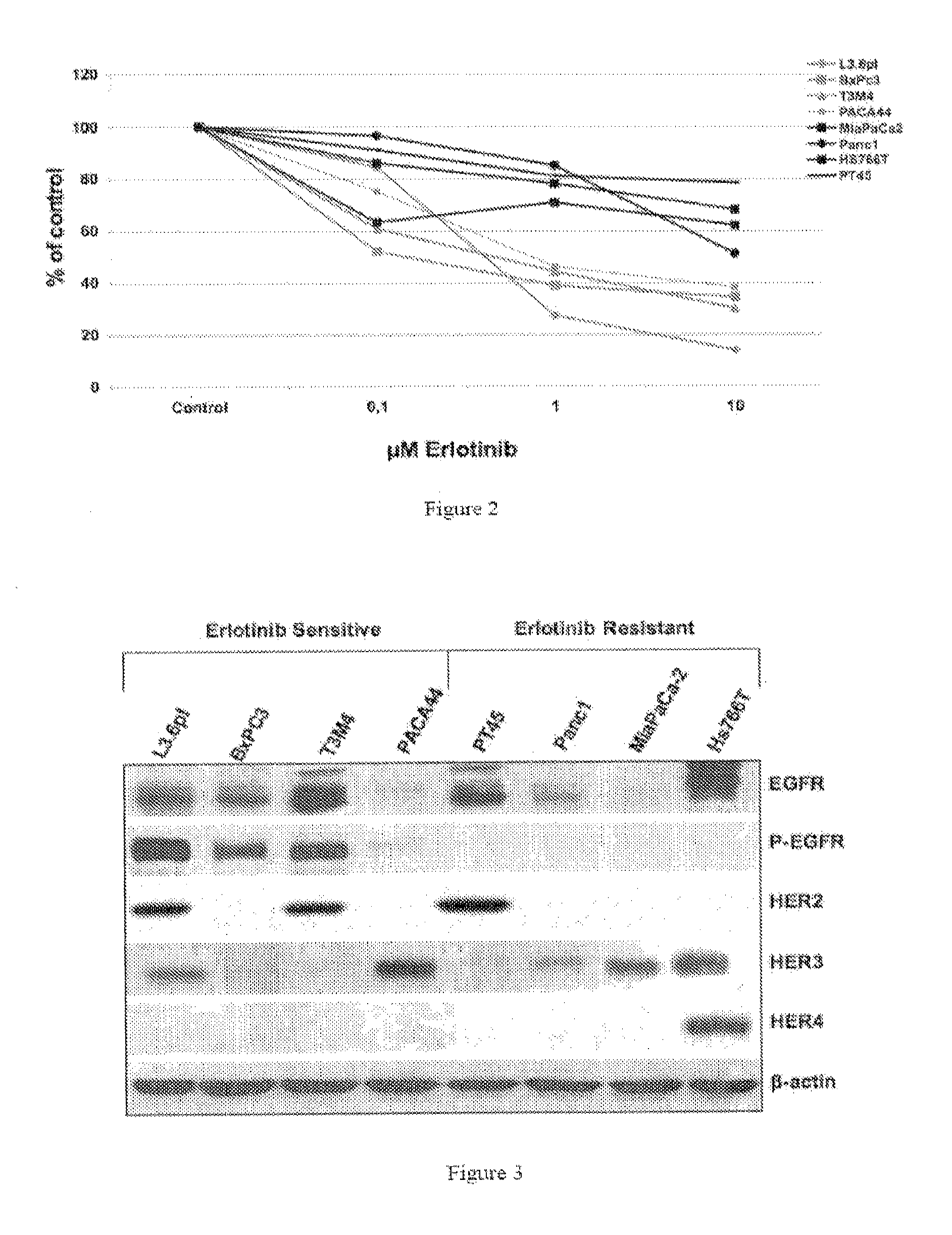Human mena isoforms serve as markers of epithelial to mesenchymal transition and sensitivity to EGFR inhibition in human cancer cells
a technology of epithelial to mesenchymal transition and human mena isoform, which is applied in the direction of material testing goods, biochemistry apparatus and processes, sugar derivatives, etc., can solve the problems of small survival improvement, ineffective treatment of all kinds of tumours and medicaments that act by inhibiting egfr activity, etc., and achieve the effect of avoiding risk
- Summary
- Abstract
- Description
- Claims
- Application Information
AI Technical Summary
Benefits of technology
Problems solved by technology
Method used
Image
Examples
example 1
hMena and hMena+11a Isoform Expression in Pancreatic Cancer-Derived Cell Lines
[0076]To acquire insights into the expression, modulation and function of the hMena and its iso form in pancreatic cancer, the hMena and hMena+11a expression was first characterized in a panel of eight pancreatic cancer cell lines by Western blot analysis. Using an anti-hMena antibody recognizing all iso forms (pan-hMena) it was observed (FIG. 1A) that hMena was consistently expressed at different level in all the tumour cell lines tested. Since hMena and hMena+11a isoforms are not distinguishable by Western blot because they co migrate (88-90 kDa), an anti-hMena+11a antibody that specifically recognize this isoform has been used. hMena+11a was selectively expressed in four out of the eight cell lines (L3.6 μl, BxPC3, T3M4 and PACA44) and in the HPDE normal cell line (data not shown), whereas it was undetectable in PT45, Panc1, MiaPaCa-2 and Hs766T cell lines. Furthermore, a two-dimensional Western blot an...
example 2
hMena+11a Isoform Expression Correlates with Sensitivity to EGFR Inhibition in Pancreatic Cancer Cell Lines
[0077]Recently we have shown that in breast cancer hMena may couple tyrosine kinase signalling to the actin cytoskeleton. In view of the role of EGFR as a relevant therapeutic target in the treatment of pancreatic cancer patients, we evaluated the growth inhibitory effect of the EGFR tyrosine-kinase inhibitor erlotinib in our panel of pancreatic cancer cell lines by exposing them to increasing concentrations (0-10 μmol / L) of the drug. As shown in FIG. 2, we observed a significant heterogeneity in drug responsiveness. Considering the average steady-state plasma concentrations in erlotinib treated patients, we divided our panel in sensitive (L3.6 μl, BxPC3, T3M4 and PACA44), displaying at least a 50% inhibition of proliferation at concentrations of erlotinib 1 μmol / L, and resistant (PT45, Panc1, MiaPaCa-2 and Hs766T) cell lines, in which the growth rate was not significantly affe...
example 3
Effect of EGF and Erlotinib Treatment on hMena Expression in Pancreatic Cancer Cell Lines
[0078]To further test the hypothesis that hMena iso forms are along the EGFR-signalling pathway, the effects of EGF have been explored and erlotinib treatment on hMena expression in BxPC3, erlotinib-sensitive, and Panc1, erlotinib-resistant cell lines. Twenty-four hours treatment with two different EGF concentrations (50 and 100 ng / ml) clearly increased hMena and hMena+11a protein level as detected by Western blot analysis in both cell lines. Furthermore, the addition of erlotinib to the EGF-treated cell lines down regulated hMena expression only in the hMena+11a positive BxPC3 cell line.
PUM
 Login to View More
Login to View More Abstract
Description
Claims
Application Information
 Login to View More
Login to View More - R&D
- Intellectual Property
- Life Sciences
- Materials
- Tech Scout
- Unparalleled Data Quality
- Higher Quality Content
- 60% Fewer Hallucinations
Browse by: Latest US Patents, China's latest patents, Technical Efficacy Thesaurus, Application Domain, Technology Topic, Popular Technical Reports.
© 2025 PatSnap. All rights reserved.Legal|Privacy policy|Modern Slavery Act Transparency Statement|Sitemap|About US| Contact US: help@patsnap.com



